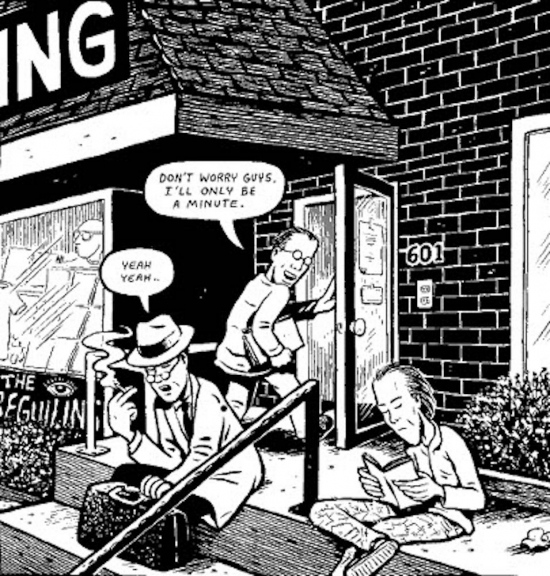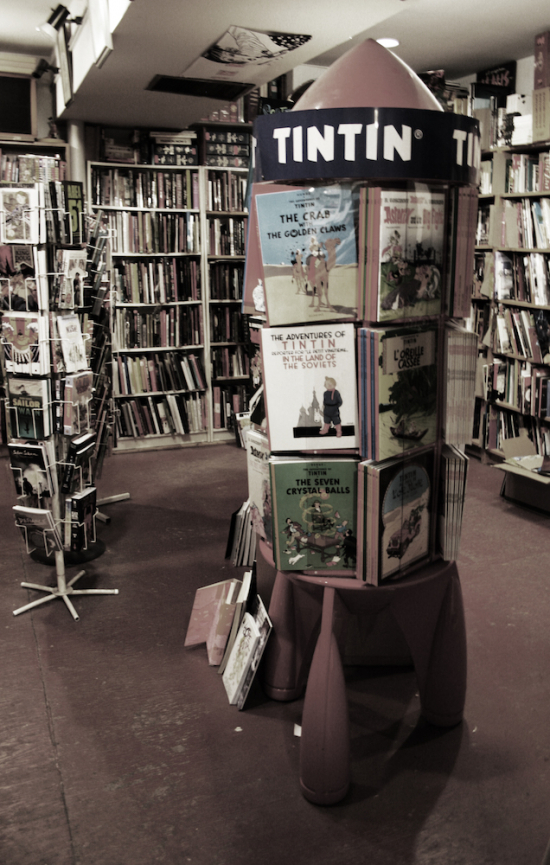Toronto. Canada. I landed here by chance – as usual – with a friend who had been warmly recommended to visit this legendary comic shop, winner of the Joe Shuster Harry Kremer Retailer Award and very active in the field of comics – since 2003 they have been organizing the Toronto Art Comics Festival. When I entered the shop I was astonished by the amount of books you can find in that little double storey woodhouse. I wrote ‘books’ because for the first time I set foot on what seemed to me an ideal comic shop: a shop that sells comics but also all those books revolving around this universe or, to put it better, a bookshop specializing in comics and comic fans. Apart from the latest bestsellers and the great classics of all times, apart from manga, superheroes and graphic novels, I spotted the big Taschen XL volume on pin-ups, but also Eugenio, the illustrated book for kids by Lorenzo Mattotti, and Canicola’s comics, which are hard to find even in Italy. There was everything you could wish and dream of, and a lot more. Wherever I turned my eyes I could find something that related to the wide horizon of those who love comics. The owner, Peter, a polite and refined Canadian, brought us to visit their other shop, which was quite near, dedicated to children: Little Island Comics – the first comic shop for children in North America, and maybe worldwide! During the night I reflected and decided to go back there the next day, which was my last one, to make an interview and share their story and their reality with #ILLUSTRATI, an idea to which I stuck also when I woke up to realize that during the night 20 cm of snow had accumulated on the streets, but this is completely normal in Canada, and everything was working perfectly. All this words about snow just to explain the photo and to give due prominence to my endeavour, because Canadians may well be used to snow and ice, but I am not.
He welcomes us as politely as the day before (should I compare him to an actor I would choose David Niven – my granny loved him) and, before telling me about the children’s comic shop, he briefly introduces The Beguiling, a place where everything – even its name – is apparently meant to seduce and fascinate comic lovers. Established at the end of the 1980s, The Beguiling soon became a benchmark thanks to the availability of various genres including underground and foreign comics. “This comic store is different from the others,” Peter proudly points out “not only for its specialization and the amount of comic books available, but also because here you can find illustrated books, albums for children, foreign books, and also volumes that aren’t actually comic books but have the same function, or volumes that are a reference for comic artists. Gradually it gained an excellent reputation, thanks to the word of mouth of customers revolving around the world of comics who used to say to each other things like ‘you have to go to The Beguiling in Toronto...’ etc.,” customers like Chester Brown and Joe Matt for example, as we can see in the cartoon in the following page. “I started as a customer,” says Peter, who is too young to have established the shop in the 1980s, “I was a teenager. I took over in 1998 and was determined to preserve its character. Many shops only focus on their best-sellers, for example Spider Man, so they buy and sell everything about Spider Man, not only comics but also any kind of gadgets. On the contrary, The Beguiling has kept its multiplicity and an open-mindedness to the various interests of its customers. For years we have been selling comics to a library specializing in science fiction, which in addition to buying comic books on this topic was interested in comic books that could help developing kids’ interest in reading, books and comics that could teach something to children. So we specialized both in sales and in contents. We have become a benchmark in the world of comics, also because we do not only attend the various events dedicated to this topic, but we get good reviews on different media, and it frequently happens that a journalist who is writing an article about comics asks us for information, because we talk about comics in a clever and open-minded way.” He stops to issue a receipt for a customer. From behind the cash register he says he has a question to ask us. “Which is the most sought-after Italian comic book in Toronto? One that has not been translated into English and French?” My friend and I look at each other. We have no idea. “ALAN FORD. In Toronto there are many immigrants from the former Yugoslavia, where Alan Ford has been the most popular comic strip for many decades. And when they come here, they can’t believe it hasn’t been translated into English. They also told me that the Yugoslav translator was a better writer than the author himself and maybe this is the reason of its great success.” I asked him too my question about female readers, to see if the situation was different on the other side of the Ocean, and he answered: “Luckily we have approximately the same number of male and female customers, but they don’t spend the same amount of money. A woman can buy three or four comic books per week, a man up to twenty-five. I wish they bought the same quantities. But, I have to say, things have changed a lot during the past ten years. Now there are women authors, and thanks to Marvel superhero movies, for example, some women even buy the Guardians of the Galaxy comics. At a certain point it seemed that all this was going to end soon. We were worried because the world of comics was completely focused on superheroes, and they were something really nerdy for men only, but now, thanks to the cinema, it’s getting more congenial to women as well... When I was six I used to read the Peanuts” Peter continues “but I didn’t buy superheroes comics until I was a teenager, I used to enjoy them on TV and play with them, but I didn’t buy comic books, I didn’t have a collector’s mind. My parents are both teachers and good readers. My father is a civil engineer so he doesn’t read novels, my mother is a literature teacher and has always been a strong reader, but neither of them reads comics. I vividly remember once I was four or five years old, I still wasn’t able to read and asked my parents to buy a comic book for me. They asked me if I wanted a Disney comic book and I said no. I wanted The Fantastic Four and they bought it, but I wasn’t able to understand it. So I asked them to read it for me and to explain it, but they weren’t able to understand it either. It was a really frustrating first experience.” He laughs. And continues seriously: “Our shop must survive, but the comic industry isn’t clever. Its protagonists are not interested in young readers; people working in this field are often also FANS, and many of them write and work for themselves, their generation and their friends. So in the 1960s comic books were addressed to kids, in the 1970s to teenagers, and so on… but now they are totally disconnected from reality. And even if superhero movies raised a great interest among children, no one bothered to produce comics for them, they focused on teenagers and adults. For children they make games, backpacks, shoes or everything else, but not books and only 2 percent of merchandising is addressed to children. As far as business is concerned, if children don’t start reading comics, in a few years there will be no more future customers, and although I don’t think this is my responsibility, and that publishers should assume it (we have the same problem with female customers, as I said before), after selling to schools and libraries for many years, we decided to take advantage of our staff’s talent in sales targeted to children and kids and open a comic shop totally dedicated to them. In 2003.”
The Beguiling Books & Art
601 Markham Street
Toronto, Ontario, Canada
mail@beguiling.com







